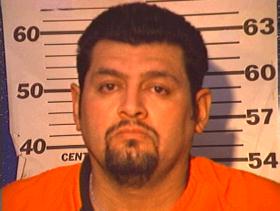
Mary Jane Rebollar’s death was brutal.
Her partially nude body was found on June 23, 2001, slumped over in a pool of blood on the passenger floorboard of a partly burned red and white Chevrolet pick-up truck with Kansas plates. The truck had been found on a dirt road in a sugarcane field near Alamo.
She had been stabbed 46 times with an unknown object that investigators with the Hidalgo County Sheriff’s Office never found.
Rebollar, 41, had been murdered two days prior after a night out at the Starz Lounge in Donna with a woman named Delia Rodriguez, who she had recently befriended after moving to the Rio Grande Valley from Lubbock.
She was dating a man named Jesus Arce and they had planned to start a business together here.
Gustavo Mireles was also at the bar on June 21, 2001 — the last night Rebollar was seen alive.
He was drinking and watching a soccer game and had spoken with her that night.
Several months later, he would be charged with arson and murder for Rebollar’s death before eventually being indicted on charges of capital murder, murder, arson and sexual assault.

All but the murder charge were eventually dropped. Then on Aug. 14, 2002, following a trial, a jury convicted him of murder and sentenced him to life in prison.
Mireles, now 55, has maintained his innocence since his arrest.
The physical evidence that convicted him included a pubic hair found in Rebollar’s purse, two bloodstains on the passenger side door of the red and white Chevrolet pick-up truck and some blood on Rebollar’s blue jeans.
Prosecutors say DNA testing showed that the blood belonged to Mireles and said he was the last person seen with Rebollar — a point all of Mireles’ attorneys have said is not true.
There was no confession in this case. There were also no known eye witnesses to the murder.
Mireles’ sister, Leonor Matano, has believed in her brother’s innocence since his arrest and said she has been advocating for her sibling to anyone who will listen since “day one,” and eventually convinced the Texas Innocence Project to take up her brother’s case.
About two weeks ago, attorney Brian S. Ehrenberg Jr. was in the 332nd state District Court — the same court where Mireles was convicted more than 20 years ago — asking Judge Mario E. Ramirez Jr. to allow the retesting of those four pieces of evidence in addition to other DNA testing that was never conducted in the case.
THE HEARING
The state of Texas is opposed to any retesting of the evidence in the case.
During a Sept. 10 hearing, Assistant District Attorney Luis Gonzalez said prosecutors are contesting one simple matter — that a convicted person must establish by the preponderance of the evidence that they would not have been convicted if exculpatory results could be obtained through DNA testing.
“Assuming testing is ordered in this case, there will be no exculpatory results,” Gonzalez said.
He said the blood on the victim’s pants, the two bloodstains on the outside of the truck and the hair in the victim’s purse all match Mireles, who cannot be excluded as a contributor, describing the DNA results as “damning.”
“The problem here is if we were to retest everything, there is nothing here that suggests that the result that connects to Gustavo was unreliable at the first trial,” Gonzalez said. “There is no reason to believe that if we were to retest the same results today, that the result would be any different.”
As for the other evidence that was either not tested or items where no DNA profile could be found, retesting and finding another profile wouldn’t prove Mireles’ innocence, he argued.
“It would merely point out that maybe someone else helped him, that someone else was there in addition to Mr. Mireles, which is not exculpatory,” Gonzalez said.
He said any other DNA belonging to someone aside from Mireles would “merely muddy the waters.”
“It would just kind of maybe at most show that someone else committed the crime in addition to the defendant,” Gonzalez said.
Ehrenberg, however, said during the hearing that the Texas Department of Public Safety crime lab in McAllen, which later moved to Weslaco, did not use the FBI’s new standard of testing in 2001 on the evidence. Mireles’ attorney also noted a lot of the evidence didn’t pull any DNA because of the way it was done.
“This can be changed now with the new DNA procedures, the way everything is finished. Moreover, some of the DNA was actually not tested. So we just ask for it all to be retested to show the possibility — to show the exculpatory evidence,” Ehrenberg said.
The attorney says that new testing will show Mireles wasn’t at the crime scene.
In fact, Ehrenberg alleges that the DNA would show that Arce and/or Rodriguez are the murderers.
Arce was Rebollar’s boyfriend, and at the time of her murder Arce was romantically involved with Rodriguez — a point the jury in Mireles’ trial never heard.
She also had a map to Arce’s house with her when her body was found, and Arce’s house was closer to her body than Mireles’ house, according to his attorney and evidence in the case.
The attorney also brought up Rebollar’s fingernail scrapings.
The medical examiner during the trial testified that the DNA evidence under Rebollar’s fingernail scrapings would show who the killer was because she most certainly fought for her life.
“The medical examiner at the time testified that the fingernails — the fingernail scraping — …actually (had) extensive defense wounds,” Ehrenberg said. “She had a broken nose. She had black eyes, cuts on her knuckles and fingers. And testified that it’s likely the perpetrator of this crime was, in fact, the DNA that’s underneath the fingernail.”
Mireles only had a small cut on his finger at the time, which he sustained while working on a vehicle, his attorney said in an interview.
Rebollar also had a clump of hair grasped in her hand when her body was found.
No one ever tested that clump of hair and it was not collected as evidence.
And at the time of the fingernail scraping testing, the DNA only matched a profile of a woman.
“If that was to come back and show that it wasn’t actually matching the standard of Mary Jane Rebollar, it would show that the actual perpetrator was someone other than Gustavo Mireles,” Ehrenberg said.
Then there’s the McAllen Crime Lab, which was actually shut down in 2003 due to an internal audit because of faulty testing procedures in sexual assault kits that occurred at the same time Mireles’ blood and hair were tested.
“This could also explain the reasoning for why Gustavo Mireles’ blood shows up,” Ehrenberg said.
In the motion for DNA testing, Ehrenberg notes that the test tube for Mireles’ blood was actually missing one-fourth of the blood it was supposed to contain before it was tested and that the evidence bag was actually not sealed.
“There is no accounting for this,” he said.
A DPS analyst did testify during the hearing that Mireles’ sample was not one of the samples targeted in the audit that closed the lab.
And Mireles was unable to explain at his trial how his DNA was found at the scene where Rebollar’s body was dumped, but his attorney suggests tampering or a mishap at the then-troubled lab.
Ramirez, the judge who presided over Mireles’ trial, has not yet ruled on whether he will order the DNA to be retested.
INNOCENCE MAINTAINED
There are two phases to trials: the guilt/innocence phase and, if there is a conviction, the punishment phase.
In trials where someone is convicted of murder, defense attorneys usually tell a jury weighing sentencing about mitigating circumstances — like childhood abuse, mental illness or other life calamities.
Attorneys will usually argue for a lesser sentence and explain how their client is ready to take responsibility for their actions.
That didn’t happen after the jury convicted Mireles of murder.
His attorney, the late Hector J. Villarreal, can only be described as incredulous of the guilty verdict.
“Lawyers traditionally start off by addressing the jury by saying, ‘May it please’ somebody. Well, it doesn’t please me to be here today,” Villarreal said at the time.
He told the 12 jurors how, contrary to popular belief, lawyers have consciences and how he and his co-counsel wondered the night before sentencing what they did wrong.
“You wonder whether you should call a witness, not have called a witness. You wonder whether you should have held back or not held back,” he said.
Then he told them that he can’t chastise them, but he doesn’t agree with them.
Villarreal reminded them that Mireles did not set the truck on fire where Rebollar’s body was found, which is why the arson charge was dismissed.
“He didn’t go out there to set a fire to burn a body that he didn’t rape, that’s why capital murder counts were thrown out, not guilty. Not dismissed, but just not guilty,” Villarreal said. “So he didn’t set the fire, and he didn’t try to rape a woman. Maybe he didn’t kill her either. And if it’s a maybe, then maybe there’s a mistake here.”
He also acknowledged that Rebollar’s murder is a tragedy and noted that Mireles is sympathetic to her family.
“He’s angry and rightfully so. He’s emotional and rightfully so,” Villarreal said of Mireles. “He’s not afraid, and I admire him for that. He’s not remorseful, but he has sympathy. You can’t be remorseful for something you didn’t do.”
As he finishes his closings, Villarreal talks about Mireles’ arrest in Corpus Christi.
Mireles had been working there hauling grain. He left for the job about 24 hours after Rebollar died.
When sheriff’s investigators obtained search warrants for his DNA, Mireles didn’t run.
He went to the Corpus Christi Police Department and cooperated.
“I’ll do it for free because this man walked into Corpus Christi PD believing in the system,” Villarreal said of representing Mireles if he were to get another trial. “He thought the system was there to protect him. The damn system failed him. He’s yours now.”
Then the jury sentenced him to life.
But before Villarreal closed and the jury sentenced him, Mireles also addressed the jurors.
“Well, ladies and gentlemen of the jury, God bless you first. And what I want to tell you is that yesterday when you walked in the jury room, you deliberated over my life,” Mireles said. “You went in there with a doubt, and I know that you have doubts because you deliberated for five hours, and then you came out and I know you came out with doubt.”
Then he told them he could put their doubt at ease.
“I did not kill this woman,” he said. “Now, one question I leave you with, who is the real killer in this case? Is it me because you think I killed someone, or is it you because you killed me when you granted that guilty verdict?
“That’s all I have to tell you. God bless you and have mercy on your soul.”
Twenty years later, Mireles still maintains his innocence and his sister, Leonor, has been there the whole time supporting her brother and believing him.
She said there’s still time for authorities to make what she, the Innocence Project of Texas and Mireles all claim is a terrible mistake.
“You started off with a lie,” she said. “End it with the right thing.”




